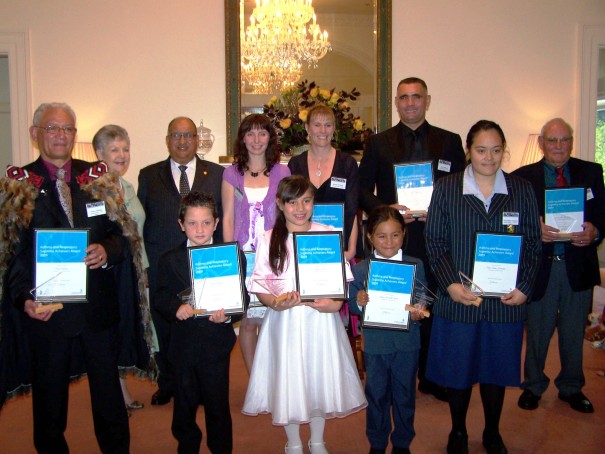Asthma and Respiratory Achievers Awards

May I begin by greeting everyone in the languages of the Realm of New Zealand, in English, Māori, Cook Island Māori, Niuean, Tokelauan and New Zealand Sign Language. Greetings, Kia Ora, Kia Orana, Fakalofa Lahi Atu, Taloha Ni and as it is evening [sign]
May I then specifically greet you: Jane Patterson, Chief Executive of the Asthma and Respiratory Foundation; Ian Patterson, President of the Foundation Board and Members of the Board; Professor Tom O’Donnell and Peter Renshaw, Life Members of the Foundation; Clare Curran; Sue Moroney; Craig Foss; Jacinta Ardern, members of Parliament; Award recipients; Distinguished Guests otherwise; ladies and gentlemen.
It is with pleasure that my wife Susan and I welcome you to Premier House in Wellington today for the presentation of the 2009 Asthma and Respiratory Achievers Awards.
We last hosted the awards at Government House Wellington in 2007; however with its closure for a major conservation project, the Prime Minister has agreed to allow his home to be used.
As Patron of the Asthma and Respiratory Foundation, I have been asked to present the awards to this year’s Supreme Achievers. However, before I do that, I would like to speak a little of the impact of asthma and respiratory diseases on our community and the work of the Foundation.
In our country, it is said, that more than eight hundred thousand people have some manner of respiratory illness. New Zealand has one of the highest rates of asthma in the world. I am told that an estimated six hundred thousand New Zealanders have asthma, including about one in four children. It is for this reason that asthma is the most common cause of hospital admission for New Zealand children.
Notwithstanding how common asthma and respiratory diseases are, they do remain largely hidden for two reasons. First, unless someone is actively wheezing heavily, it is often difficult to tell at first sight whether they have a respiratory illness.
Secondly, if it is not properly managed, someone affected by an asthma or respiratory disease may be lead to an increasingly isolated lifestyle, resulting in limited engagement with their community.
On that note, my wife Susan and I would like to extend our thanks for the contribution this organisation makes to the New Zealand community and the support that it offers to those living with an asthma or respiratory disease.
Since 1964, that is, for 45 years, the Asthma and Respiratory Foundation of New Zealand and its affiliated societies and branches, have worked tirelessly in pioneering the way for asthma education, research and training. The Foundation is the voice for those that live with the effects of respiratory diseases and it continues to fund research in an effort to find treatments to ease symptoms, and one day to find a cure.
The Foundation has led a number of initiatives that have impacted on nationwide education surrounding asthma and other respiratory diseases. These include things such as Asthma Awareness Week and Balloon Day in May, the Sensitive Choice programme, and the Asthma Friendly Schools programme.
These are all excellent examples of outstanding work that the Foundation continues to do to advocate for sufferers of respiratory diseases.
Among Māori people, while the incidence is similar to the general population, respiratory illnesses result in a far higher proportion of sickness and deaths. The Foundation has therefore developed a Māori Responsiveness Plan and have been interested to note its three key themes of: Building Partnerships with Māori; Being Responsive to Māori; and Being Effective for Māori.
The Asthma and Respiratory Achievers Awards, which have been awarded every two years since 1999, recognise those who have not let their condition hold them back despite the challenges they face in their daily lives.
I wish to congratulate the Foundation on this initiative. It is a reminder of the courage of those individuals who live with the effects of asthma or other respiratory illnesses. Despite the challenges that they face in managing their illness, they still achieve great things whether it is within their community or on a national scale, or in some cases, both! Those receiving awards today, and those who have received awards in the past, provide role models for New Zealanders living with these diseases.
As to role models, something said recently by the world renowned golfer, Tiger Woods appealed to me to be repeated. Tiger said:-
“I think it's an honour to be a role model to one person or maybe more than that. If you are given a chance to be a role model, I think you should always take it because you can influence a person's life in a positive light, and that's what I want to do. That's what it's all about. ”
I applaud not only the nine award recipients here this evening, but also everyone who was nominated. Your achievements are an inspiration to everyone.
See the 2009 Asthma and Respiratory Achievers Awards image gallery for more images.
I also extend my thanks to all who were involved in organising and supporting this occasion and wish the Asthma and Respiratory Foundation of New Zealand all the best for its ongoing, invaluable work.
On that note, I will close in our country’s first language, offering everyone greetings and wishing you good health and fortitude in your endeavours.
No reira, tēnā koutou, tēnā koutou, kia ora, kia kaha, tēnā koutou katoa.
More images from this event at: 2009 Asthma and Respiratory Achievers Awards.
